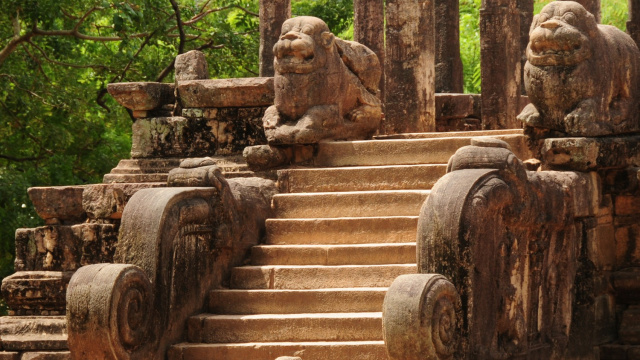Sri Lanka

Polonnaruwa
Polonnaruwa, the medieval capital of the country during the Chola dynasty.
Polonnaruwa, Sri Lanka's medieval capital, is a place of rich history and archaeological significance. Located in the north central province of the country, it was the political and cultural centre during the Chola dynasty and later the kings of Sri Lanka from the 10th to the 13th century.
The city is dotted with iconic monuments that testify to the flourishing of Buddhism and the architectural evolution of the time. One of the most famous is the Gal Vihara, a complex of four Buddha statues carved into a single rock. The statues, depicting the Buddha in various poses, are striking in their harmony and artistry.
The Vatadage, with its characteristic circular structure and elaborate decorations, is another point of interest. The stupa at its centre is surrounded by four entrances, each of which symbolizes the four directions of the world.
Also standing out is the Palace of King Parakramabahu, a magnificent structure that includes a seven-storey tower, great halls and walls that protect the heart of the palace. The Parakrama Samudra Lake, the work of the same king, is an impressive example of ancient engineering and continues to be functional to this day.
Polonnaruwa is not just an archaeological site; it is a living testimony to Sri Lanka's golden age and its cultural heritage.
The city is dotted with iconic monuments that testify to the flourishing of Buddhism and the architectural evolution of the time. One of the most famous is the Gal Vihara, a complex of four Buddha statues carved into a single rock. The statues, depicting the Buddha in various poses, are striking in their harmony and artistry.
The Vatadage, with its characteristic circular structure and elaborate decorations, is another point of interest. The stupa at its centre is surrounded by four entrances, each of which symbolizes the four directions of the world.
Also standing out is the Palace of King Parakramabahu, a magnificent structure that includes a seven-storey tower, great halls and walls that protect the heart of the palace. The Parakrama Samudra Lake, the work of the same king, is an impressive example of ancient engineering and continues to be functional to this day.
Polonnaruwa is not just an archaeological site; it is a living testimony to Sri Lanka's golden age and its cultural heritage.

Dambulla
The temple, built in five caves, is home to ancient sculptures and frescoes of the Buddha.

Sigiriya
The huge rock, 200 metres high, formed the core of the Kasyapa kingdom in the 5th century AD.

Colombo
Colombo is the bustling capital of the country.

Pidurangala
At the top of the cliff you can enjoy a spectacular view of the green valley of the area and the Sigiriya rock.

Polonnaruwa
Polonnaruwa, the medieval capital of the country during the Chola dynasty.

Minneriya National Park
The park has rich ecosystems, including dense forests, open meadows and wetlands.

Kandy
In the city of Kandy, the heart of Buddhism beats because of the sacred "temple of the tooth".

Knuckles National Park
The park has been recognized by UNESCO as a habitat of global importance.

Heeloya
For hiking and nature lovers, Heeloya is an ideal destination.

Garandiala waterfall
A popular destination for visitors seeking an experience full of natural beauty and history.

Ella
Ella is a green town in the heart of tea country, offering endless opportunities for outdoor activities.

Knuckles
The Knuckles Range is an important habitat protected by UNESCO.

Ella Rock
One of the most popular hiking destinations in the Ella area.

Train Tracks
The train ride through the heart of the countryside is one of the most scenic in the world.

Tea Plantations
The tea plantation experience is a combination of natural beauty, cultural knowledge and enjoyment.

Eucalyptus Forest
This majestic forest is known for the dense eucalyptus trees that cover it.

Nine Arches Bridge
A symbol of the meeting of human creativity and natural beauty.

Waterfall Diyaluma
One of the highest waterfalls in South Asia, reaching a height of 220 metres.

Yala National Park
This beautiful wildlife sanctuary, which is the second largest in the country, is known for its rich biodiversity.

Tangalle
This area is known for its stunning beaches, characterized by crystal clear waters and white sandy beaches.

Ruhunu
The area is full of dense forests, waterfalls and rivers, offering an ideal destination for nature lovers.

Galle
The town of Galle is a picturesque town with strong Dutch and Portuguese colonial elements, classified as a Unesco heritage site.